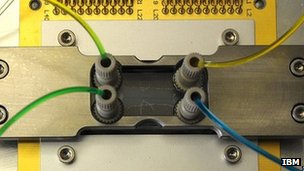IBM Zurich told how electronic blood works
 IBM continues to experiment with technologies that resemble the principles of the human brain. Earlier it was already reported about chips for a neurocomputer with silicon analogs of neurons and synapses, and also about simulating the work of the human brain with the help of such chips.
IBM continues to experiment with technologies that resemble the principles of the human brain. Earlier it was already reported about chips for a neurocomputer with silicon analogs of neurons and synapses, and also about simulating the work of the human brain with the help of such chips.Last week, IBM organized a press tour of the laboratories of the IBM Zurich Research Center, where the main research in the field of "cognitive systems" is concentrated. This is work on computers of the distant future, performance in petaflops, capable of not only performing the programmed commands, but also perceive the surrounding reality, make judgments, communicate in a natural human language and learn from their own experience.
IBM's goal is to create a compact computer with a capacity of 1 petaflops over the next decades, solving the problems with chip packing density and cooling.
The well-known IBM Watson, which already diagnoses statistically more accurately than living doctors , is the first step towards the era of cognitive systems. But the main problems that stand in this way are energy efficiency and compactness of supercomputers of the future. IBM Zurich director Matthias Kaiserswerth explained that not a single modern computer can even compare closely with the power and energy efficiency of the human brain.
')
And if you catch up with the brain in computing power - a relatively simple task, the question is only in the number of processors, then no one even imagines how a digital machine can compare with it in terms of energy efficiency. Mattias Kaiservert said that Watson consumes 85 kW and the human brain only 20 watts. The biological design also benefits in terms of packing density.
To increase the density, IBM proposes using the 3D architecture shown in the illustration. The processors are stacked and placed on motherboards, which are also then stacked.

The aforementioned “electronic blood” (electronic blood) is an IBM conceptual experiment that theoretically can solve two problems at once: cooling the computer and delivering power to the chips. As in the human brain, both of these tasks can be solved using liquid electrolyte.
Liquid chip cooling is already a proven technology, there are chip models even with integrated tubes for cooling.

Much more interesting, as the same liquid will supply the chips with energy. IBM specialists explain that they use the redox reaction for this. Vanadium-based liquid electrolytes receive negative and positive charges on the electrodes — and are sent through a thin network of capillaries to the processor, where they release the charge and simultaneously cool the chips.

At the moment, the installation is capable of transmitting up to 1 watt of energy per square centimeter.

By the way, the IBM Zurich division cooperates with the European scientific project Human Brain Project and promises to provide scientists with equipment to create the most accurate simulation of the human brain.
Source: https://habr.com/ru/post/198550/
All Articles